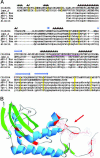Comparative structural modeling and inference of conserved protein classes in Drosophila seminal fluid
- PMID: 15345744
- PMCID: PMC518759
- DOI: 10.1073/pnas.0405579101
Comparative structural modeling and inference of conserved protein classes in Drosophila seminal fluid
Abstract
The constituents of seminal fluid are a complex mixture of proteins and other molecules, most of whose functions have yet to be determined and many of which are rapidly evolving. As a step in elucidating the roles of these proteins and exposing potential functional similarities hidden by their rapid evolution, we performed comparative structural modeling on 28 of 52 predicted seminal proteins produced in the Drosophila melanogaster male accessory gland. Each model was characterized by defining residues likely to be important for structure and function. Comparisons of known protein structures with predicted accessory gland proteins (Acps) revealed similarities undetectable by primary sequence alignments. The structures predict that Acps fall into several categories: regulators of proteolysis, lipid modifiers, immunity/protection, sperm-binding proteins, and peptide hormones. The comparative structural modeling approach indicates that major functional classes of mammalian and Drosophila seminal fluid proteins are conserved, despite differences in reproductive strategies. This is particularly striking in the face of the rapid protein sequence evolution that characterizes many reproductive proteins, including Drosophila and mammalian seminal proteins.
Figures



Similar articles
-
Evidence for structural constraint on ovulin, a rapidly evolving Drosophila melanogaster seminal protein.Proc Natl Acad Sci U S A. 2006 Dec 5;103(49):18644-9. doi: 10.1073/pnas.0601849103. Epub 2006 Nov 27. Proc Natl Acad Sci U S A. 2006. PMID: 17130459 Free PMC article.
-
The Drosophila melanogaster seminal fluid protein Acp62F is a protease inhibitor that is toxic upon ectopic expression.Genetics. 2002 Jan;160(1):211-24. doi: 10.1093/genetics/160.1.211. Genetics. 2002. PMID: 11805057 Free PMC article.
-
Proteomic analysis of Drosophila mojavensis male accessory glands suggests novel classes of seminal fluid proteins.Insect Biochem Mol Biol. 2009 May-Jun;39(5-6):366-71. doi: 10.1016/j.ibmb.2009.03.003. Epub 2009 Mar 28. Insect Biochem Mol Biol. 2009. PMID: 19328853
-
"S.P.E.R.M." (seminal proteins (are) essential reproductive modulators): the view from Drosophila.Soc Reprod Fertil Suppl. 2007;65:183-99. Soc Reprod Fertil Suppl. 2007. PMID: 17644962 Review.
-
The gifts that keep on giving: physiological functions and evolutionary dynamics of male seminal proteins in Drosophila.Heredity (Edinb). 2002 Feb;88(2):85-93. doi: 10.1038/sj.hdy.6800017. Heredity (Edinb). 2002. PMID: 11932766 Review.
Cited by
-
The Drosophila melanogaster seminal fluid protease "seminase" regulates proteolytic and post-mating reproductive processes.PLoS Genet. 2012 Jan;8(1):e1002435. doi: 10.1371/journal.pgen.1002435. Epub 2012 Jan 12. PLoS Genet. 2012. PMID: 22253601 Free PMC article.
-
Molecular characterization of iron binding proteins from Glossina morsitans morsitans (Diptera: Glossinidae).Insect Biochem Mol Biol. 2006 Dec;36(12):921-33. doi: 10.1016/j.ibmb.2006.09.003. Epub 2006 Sep 26. Insect Biochem Mol Biol. 2006. PMID: 17098167 Free PMC article.
-
Mining gene expression data for pollutants (dioxin, toluene, formaldehyde) and low dose of gamma-irradiation.PLoS One. 2014 Jan 24;9(1):e86051. doi: 10.1371/journal.pone.0086051. eCollection 2014. PLoS One. 2014. PMID: 24475070 Free PMC article.
-
Proteome analysis of male accessory gland secretions in oriental fruit flies reveals juvenile hormone-binding protein, suggesting impact on female reproduction.Sci Rep. 2015 Nov 19;5:16845. doi: 10.1038/srep16845. Sci Rep. 2015. PMID: 26582577 Free PMC article.
-
Molecular characterization of firefly nuptial gifts: a multi-omics approach sheds light on postcopulatory sexual selection.Sci Rep. 2016 Dec 22;6:38556. doi: 10.1038/srep38556. Sci Rep. 2016. PMID: 28004739 Free PMC article.
References
-
- Wolfner, M. F. (2002) Heredity 88, 85–93. - PubMed
-
- Wolfner, M. F., Harada, H. A., Bertram, M. J., Stelick, T. J., Kraus, K. W., Kalb, J. M., Lung, Y. O., Neubaum, D. M., Park, M. & Tram, U. (1997) Insect Biochem. Mol. Biol. 27, 825–834. - PubMed
-
- Monsma, S. A., Harada, H. A. & Wolfner, M. F. (1990) Dev. Biol. 142, 465–475. - PubMed
-
- Chen, P. S., Stumm-Zollinger, E., Aigaki, T., Balmer, J., Bienz, M. & Bohlen, P. (1988) Cell 54, 291–298. - PubMed
Publication types
MeSH terms
Substances
Grants and funding
LinkOut - more resources
Full Text Sources
Molecular Biology Databases
Research Materials

